- cavalier king charles spaniel
- bichon frise
- havanese
- shih tzu
- chinese crested
- greyhound
- maltese
- apartment
- french bulldog
- bulldog
- small dogs
- small breeds
- pug
- temperament
Generally speaking, smaller dog breeds can make good companion dogs for apartments or condominiums. They adapt well in confined spaces, and they don’t need a tremendous amount of exercise to keep them happy and healthy. But there are many dog breeds that make good choices for apartments, some of which you may not expect!
Bulldog
The Bulldog, to the best of our knowledge, had its origin in the British Isles. The name “bull” was applied because of the dog’s use in the sport of bullbaiting. In the 19th century, the sport became illegal in England. However, there were dog lovers who felt deep disappointment at the passing of the breed, and they set themselves the task of preserving it.

They proceeded to eliminate the undesirable fierce characteristics and to preserve and accentuate the finer qualities. Within a few generations, the English Bulldog became one of the finest physical specimens, with a wholly different temperament.
We may be justly proud of the Bulldog we know today, and we must express our gratitude to our British cousins who realized the value of the breed sufficiently to preserve them for posterity.
Shih Tzu
The exact date of origin of the Shih Tzu is not known, but evidence of its existence has come to us from documents, paintings, and objets d’art dating from 624 A.D. During the Tang Dynasty (618 to 907 A.D.), the King of Viqur gave the Chinese court a pair of dogs said to have come from the Fu Lin (assumed to be the Byzantine Empire).
Another theory of their introduction to China was recorded in the mid-17th century (when dogs were brought from Tibet to the Chinese court). These dogs were bred in the Forbidden City of Peking. The smallest of these dogs resembled a lion, as represented in art. “Shih Tzu” means “lion.” The Shih Tzu is reported to be the oldest and smallest of the Tibetan holy dogs, the lion being associated with the Buddhist deity.
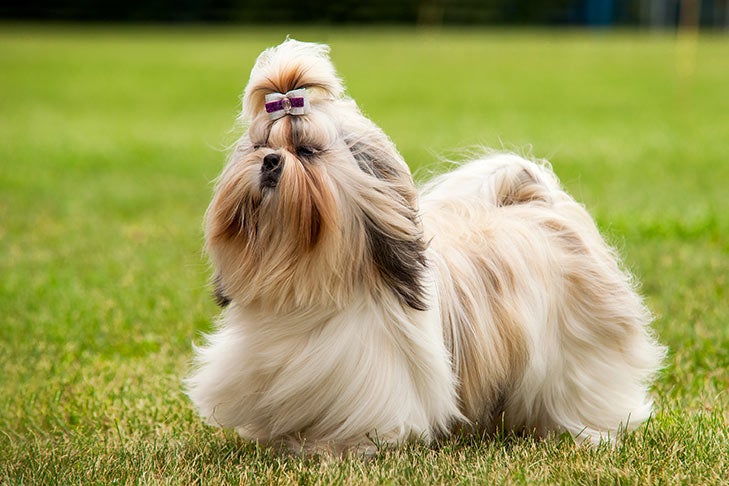
These dogs were bred by the Chinese court and from them the dog we know today as the Shih Tzu developed. They are also called “the chrysanthemum-faced dog” because the hair grows about the face in all directions. Dowager Empress Cixi (T’zu Hsi) kept an important kennel of Pugs, Pekingese, and Shih Tzu. After her death in 1908, the dogs were dispersed and breeding mostly ceased.
When the Communist Revolution occurred in China, the breed became almost extinct. Every Shih Tzu today can be traced to 14 dogs—seven bitches and seven dogs—some of whom were imported to England where breeding of the Shih Tzu began in 1930. There, the breed was first classified as “Apsos,” but after a ruling by the Kennel Club (England) that Lhasa Apsos and Shih Tzus were separate breeds, the Shih Tzu Club of England was formed in 1935.

Members of the breed were exported from England to other countries in Europe and Australia. American soldiers stationed in these countries brought the breed back to the United States, thus introducing them to this country. The Shih Tzu was admitted to registration in the American Kennel Club Stud Book in March 1969, and to regular show classification in the Toy Group at AKC shows beginning September 1, 1969.
Cavalier King Charles Spaniel

Today’s Cavalier is directly modeled on its royal ancestors, but this did not happen without the effort of an American fancier named Roswell Eldridge. Eldridge traveled to England in the early 1920s, hoping to buy two spaniels. He was unsuccessful, finding a diversity of types and none of the “old type,” particularly the head type he desired. Roswell offered prizes of 25 pounds to the best male and best female of the “old type” exhibited at Crufts each year. The motivation worked. Interest was generated among breeders to revive the original spaniel.

In 1952, the first Cavaliers were sent to America and a national breed club was formed soon after, but because of the small numbers of Cavaliers, they did not gain full breed recognition for 40 years. January 1, 1996, saw the Cavalier King Charles Spaniel enter the American Kennel Club competition as the 140th recognized breed.
Pug
The truth of how the Pug came into existence is shrouded in mystery, but they have been true to their breed since before 400 B.C. Authorities agree that the Pug is of East Asian origin with some basic similarities to the Pekingese.

China is the earliest known source for the breed, where they were the pets in the Buddhist monasteries in Tibet. The breed next appeared in Japan and then in Europe, where it became the favorite of various royal courts.
The Pug became the official dog of the House of Orange after a Pug saved the life of William, Prince of Orange, by giving alarm at the approach of the Spaniards at Hermingny in 1572. Later, when the future King William II landed at Torbay to be crowned ruler of England, his cortege included Pugs, and these dogs became a fashionable breed for generations. By 1790, the Pug’s popularity has spread to France, where Josephine, wife of Napoleon, depended on her Pug “Fortune” to carry secret messages under his collar to her husband while she was imprisoned at Les Carme.
In 1860, British soldiers sacked the Imperial Palace in Peking, bringing dogs of the Pug and Pekingese type back to England. This was the first time since the early 16th century that dogs in any great number had been taken out of China. Black Pugs were imported from China and exhibited for the first time in England in 1886. One year earlier, the Pug had been accepted for registration with the American Kennel Club.

The Pug is well-described by the phrase “multum in parvo,” which means “a lot of dog in a small space.” They are small but require no coddling and their roguish face soon wiggles its way into the hearts of adults and especially children, for whom this dog seems to have a special affinity. Their great reason for living is to be near their owners and to please them. The Pug is comfortable in a small apartment or country home alike, easily adaptable to all situations.
Bichon Frise
The Bichon Frise descended from the Barbet or Water Spaniel, from which came the name “Barbichon,” later shortened to “Bichon.” The Bichons were divided into four categories—the Bichon Maltais, the Bichon Bolognais, the Bichon Havanais, and the Bichon Teneriffe. All originated in the Mediterranean area.

Because of their merry disposition, they traveled much and were often used as items of barter by sailors as they moved from continent to continent. The dogs found early success in Spain and it is generally felt that Spanish seamen introduced the breed to the Canary Island of Tenerife. In the 1300s, Italian sailors rediscovered the little dogs on their voyages and are credited with returning them to the Continent, where they became great favorites of Italian nobility.
The “Teneriffe” or “Bichon” had success in France during the Renaissance under Francis I (1515-47) but its popularity skyrocketed in the court of Henry III (1574-89). The breed also enjoyed considerable success in Spain as a favorite of the royal princesses, and painters of the Spanish school often included them in their works. For example, the Spanish artist Goya included a Bichon in several of his works.
Interest in the breed was renewed during the rule of Napoleon III, but then waned until the late 1800s. Then, the Bichon became the “common dog,” running the streets, accompanying organ grinders, leading the blind, and doing tricks in circuses and fairs.
On March 5, 1933, the official standard of the breed was adopted by La Société Centrale Canine of France. As the breed was known by two names at that time, “Teneriffe” and “Bichon,” the president of the International Canine Federation proposed a name based on the characteristics that the dogs presented—the Bichon Frise (“Frise” refers to the dog’s soft, curly hair). On October 18, 1934, the Bichon Frise was admitted to the stud book of the French Kennel Club.

The first Bichon litter was whelped in the U.S. in 1956. In 1959 and 1960, two breeders in different parts of the U.S. acquired Bichons. This provided the origins for the breed’s development in this country. The Bichon Frise became eligible to enter the Miscellaneous Class on September 1, 1971. In 1972, the breed was admitted to registration in the American Kennel Club Stud Book. On April 4, 1973, the breed became eligible to show in the Non-Sporting Group at AKC dog shows.
French Bulldog
There is a difference of opinion as to the origin of the French Bulldog, but one ancestor must have been the English Bulldog, probably one of the toy variety, of which there was a great number in England around 1860.

These toy Bulldogs were sent in large numbers into France, where they were crossed with various other breeds and were given the name Boule-Dog Francais. One found dogs with rose ears, while others had bat ears, which are now an outstanding feature of the French Bulldog.
Another distinctive feature of the French Bulldog is the skull. The correctly formed skull should be level, or flat, between the ears, while directly above the eyes, extending almost across the forehead, it should be slightly curved, giving a domed appearance. This controversy over type was responsible for the formation of the French Bulldog Club of America, the first organization in the world devoted to the breed.
In 1898, fanciers gave a specialty show in the ballroom of the Waldorf-Astoria. The affair proved a sensation, and it was due, no doubt, to the resulting publicity that the quaint little dogs became the rage in society.

Greyhound
The Greyhound is one of the most ancient breeds known today and can be traced to almost every country on the globe.
In America, Greyhounds can be traced back to the 1500s, brought in by Spanish explorers to “guard, hunt, intimidate and punish their enemies”—in this case, Indigenous peoples. During the American Revolution, a huge Greyhound named Azor always accompanied George Washington.

The first evidence of the breed was discovered in Egypt, with carvings in old tombs dating back to 2900 and 2751 B.C. depicting dogs of Greyhound type attacking deer and mountain goats. While these Egyptian scenes established Greyhounds at a very early date, the first complete description of the breed comes from a Roman source, written by Ovid, who lived from 43 B.C. to 17 A.D.
Greyhounds were among the first dogs recorded at American dog shows, with an entry of 18 exhibited at the Westminster Kennel Club show in 1877. They were in the second edition of the AKC Stud Book in 1885 with listings of three males and five bitches.
Aristocracy and culture have always surrounded the Greyhound, and in early times only royalty bred them. England has played an important role in the development of the breed, with the first illustrations dating back to the 9th century. It was used on practically all kinds of game, from deer, stags, foxes, and such, but the hare is the Greyhound’s natural quarry. Formal coursing events came onto the scene over two centuries ago.
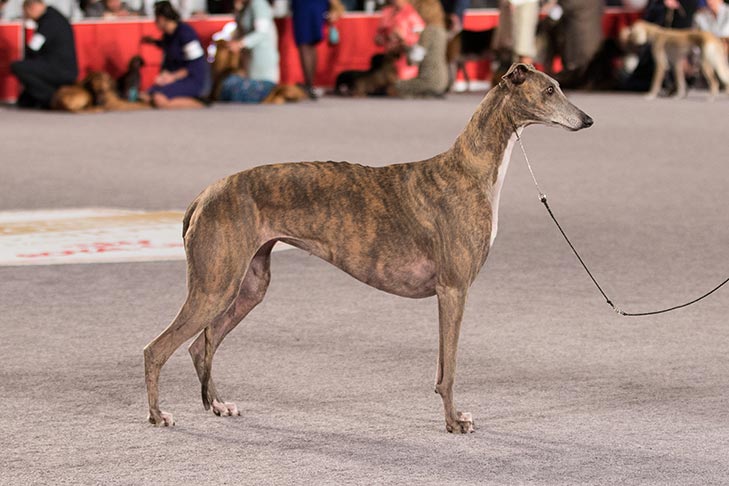
Today the breed’s most valued trait is companionship. They’re lovely dogs with lively personalities.
Havanese
The Havanese is an old breed with title to a colorful history. The Havanese is the national dog of Cuba and its only native breed. The dog’s journey to Cuba most likely was aboard the trade ships sailing from the island of Tenerife in the early 16th century.
Cuban trade was highly restricted by the Spanish, for many years allowing Tenerife to be one of the only open ports. These little dogs apparently found their way into homes of Cuban aristocracy developed without much outside influence.
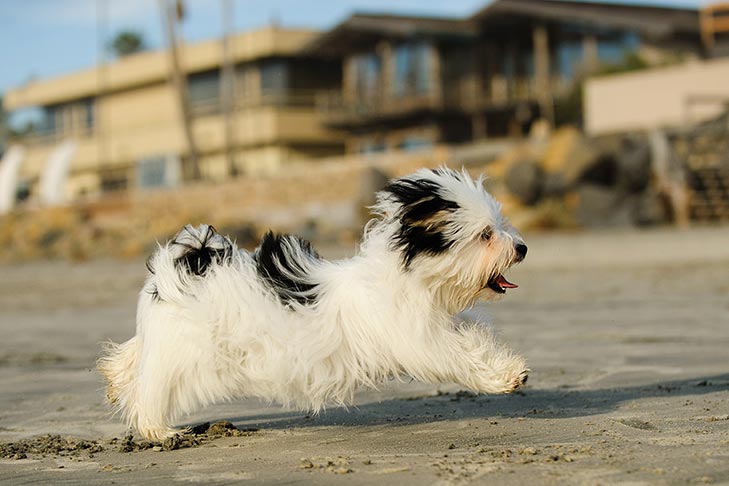
The tropical environs of their homeland appear to have influenced the Havanese development, specifically their unique coat texture. Once called the Havana Silk Dog, or the Spanish Silk Poodle, the coat is like raw silk floss, profuse but extremely light and soft, insulating and protective of harsh tropical rays.
As colonial Cuba developed and prospered the popularity of the Havanese grew. As Cuban culture shifted, the little dog of Havana, adaptable as always, became a family dog extraordinaire, playmate of children, watchdog, and herder of the family poultry flock. By the mid-18th century, they were trendy in Europe, often exhibited in European dog shows, and the type was well-established. All the Havanese in the world today, save those from former Soviet Union countries and those remaining in Cuba, stem from 11 little immigrant canines.
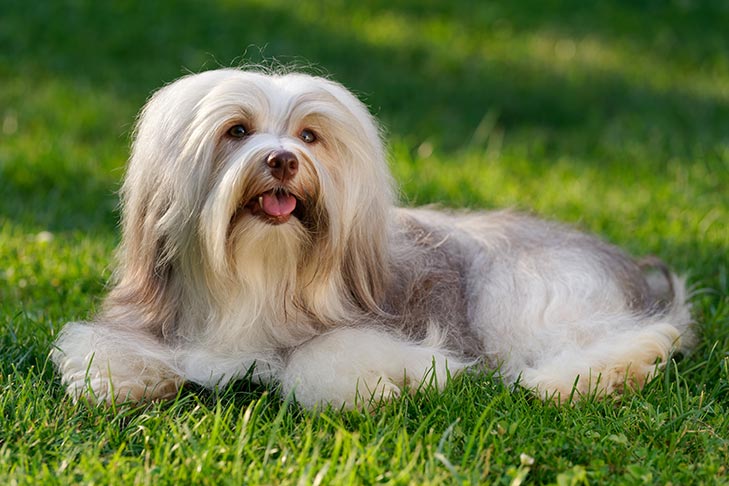
With the advent of the Cuban Revolution, the class of Cubans who owned Havanese was the first to emigrate. Remarkably, through all their travels, the Havanese type and purpose have remained virtually unchanged for the past 150 years. A handful of them found their way to the United States, and by the end of the 1970s, a gene pool was being rebuilt.
Maltese
The Maltese, the ancient dog of Malta, has been known as an aristocrat of the canine world for more than 28 centuries. Their place in antiquity is well-documented. The Greeks erected tombs for their Maltese, and in ceramic art dating to the 5th century, innumerable paintings of the little dog are evident.
In the time of the Apostle Paul, Publius, the Roman governor of Malta, had a Maltese named Issa of whom he was very fond. The poet Marcus Valerius Martialis (Martial), born in 40 A.D. in Spain, wrote one of his celebrated epigrams about Issa. Literary accounts detail the Maltese maintaining a place of esteem and privilege in royal households, a status the breed has maintained throughout history.

The first Maltese exhibited in the United States was white and listed as a Maltese Lion Dog at Westminster’s first show in 1877. The American Kennel Club accepted the Maltese for registration in 1888.
Perhaps due to the popularity of the Maltese for centuries as household pets of people of culture, wealth, and fastidious taste, the Maltese has remained a symbol of refinement, fidelity, and cleanliness. Many similar accounts in ancient doctrine address the Maltese as an object of beauty and value.
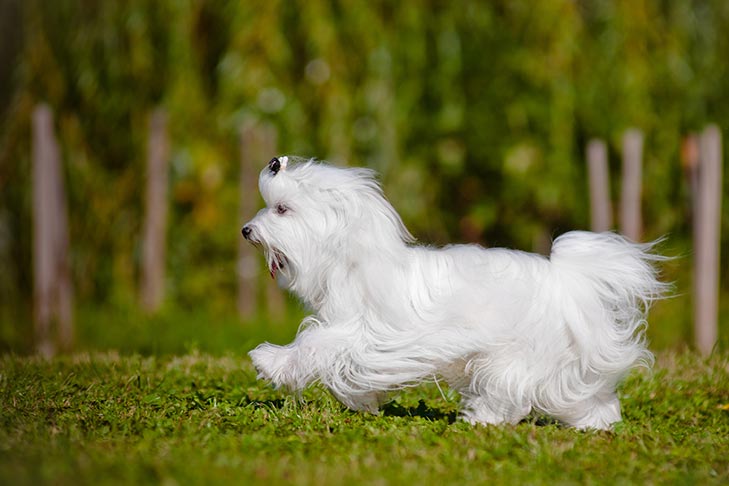
The Maltese is a spaniel with a healthy and spirited temperament, even though they are tiny and artistic in appearance.
Chinese Crested
The Chinese Crested is believed to have evolved from the African hairless dogs. These dogs were traded among merchants and sailors, which is how they made their way to ancient port cities around the world. The Chinese, who seemed to favor dogs of smaller size, selectively bred the African hairless to a smaller size and continued an active trade.

Explorers, as early as the 1500s, found these dogs in ports throughout Central and South America, as well as African and Asian cities. Chinese Cresteds joined the breeds depicted in European art and architecture in the 19th century. The breed is also represented in photos of English competitions from the era, but no breeding program was evidenced.
The Crested acquired an active and enthusiastic following in the United States in the early 1900s. Breeders kept an extensive stud book and registry beginning in the 1930s. Gypsy Rose Lee, the famous stage personality, acquired a Crested in the 1950s and became an ardent breeder helping considerably to publicize the breed. The Chinese Crested was first registered with the American Kennel Club in 1991.
At AKC Marketplace, we can help you find your dream dog. You can find AKC-registerable puppies from responsible, passionate breeders, and we provide the tools you need for every step of the process. Visit marketplace.akc.org to start connecting with dog breeders in your area!

